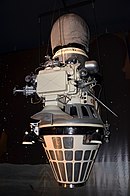Luna 4
 Model of Luna 4. | |
| Mission type | Lunar lander |
|---|---|
| Operator | Soviet Union |
| COSPAR ID | 1963-008B |
| SATCAT no. | 566 |
| Mission duration | 5 days (planned) |
| Spacecraft properties | |
| Manufacturer | OKB-1 |
| Launch mass | 1,422 kilograms (3,135 lb) |
| Start of mission | |
| Launch date | April 2, 1963, 08:04:00 UTC |
| Rocket | Molniya-L 8K78/E6 |
| Launch site | Baikonur 1/5 |
| Orbital parameters | |
| Reference system | Barycentric (Earth-Moon system) |
| Semi-major axis | 394,128 kilometres (244,900 mi) |
| Eccentricity | 0.772 |
| Periapsis altitude | 89,801 kilometres (55,800 mi) |
| Apoapsis altitude | 698,455 kilometres (434,000 mi) |
| Inclination | 65.0 degrees |
| Period | 28.365 days |
| Lunar flyby (failed landing) | |
| Closest approach | April 5, 1963, 13:25 UTC |
| Distance | 8,336.2 kilometres (5,179.9 mi) |
Luna 4, or E-6 No.4 was a Soviet spacecraft launched as part of the Luna program to attempt the first soft landing on the Moon. Following a successful launch, the spacecraft failed to perform a course correction and as a result it missed the moon, remaining instead in Earth orbit.
Mission
Luna 4 was launched by a Molniya-L carrier rocket at 08:16:37 UTC on 2 April 1963. Launch occurred from Site 1/5 at the Baikonur Cosmodrome. After reaching an initial parking orbit of 167 by 182 kilometres (104 by 113 mi), the rocket's upper stage restarted to place Luna 4 onto a translunar trajectory.
The spacecraft did not perform a required midcourse correction manoeuvre, which resulted in it missing the Moon by 8,336.2 kilometres (5,179.9 mi) at 13:25 UT on April 5, 1963. It then entered a barycentric 90,000 × 700,000 km Earth orbit. A lecture program entitled "Hitting the Moon" was scheduled to be broadcast on Radio Moscow at 7:45 p.m. the evening of April 5 but was cancelled. The spacecraft transmitted at 183.6 MHz at least until April 6.
Lunar surface close-up photography
The purpose of this experiment was to obtain information on the characteristics of the lunar surface. These characteristics include the amount of cratering, structure and size of craters, the amount, distribution, and sizes of ejecta, mechanical properties of the surface such as bearing strength, cohesiveness, compaction, etc. Determination and recognition of processes operating to produce the lunar surface features also were among the objectives of this photographic experiment.
External links
